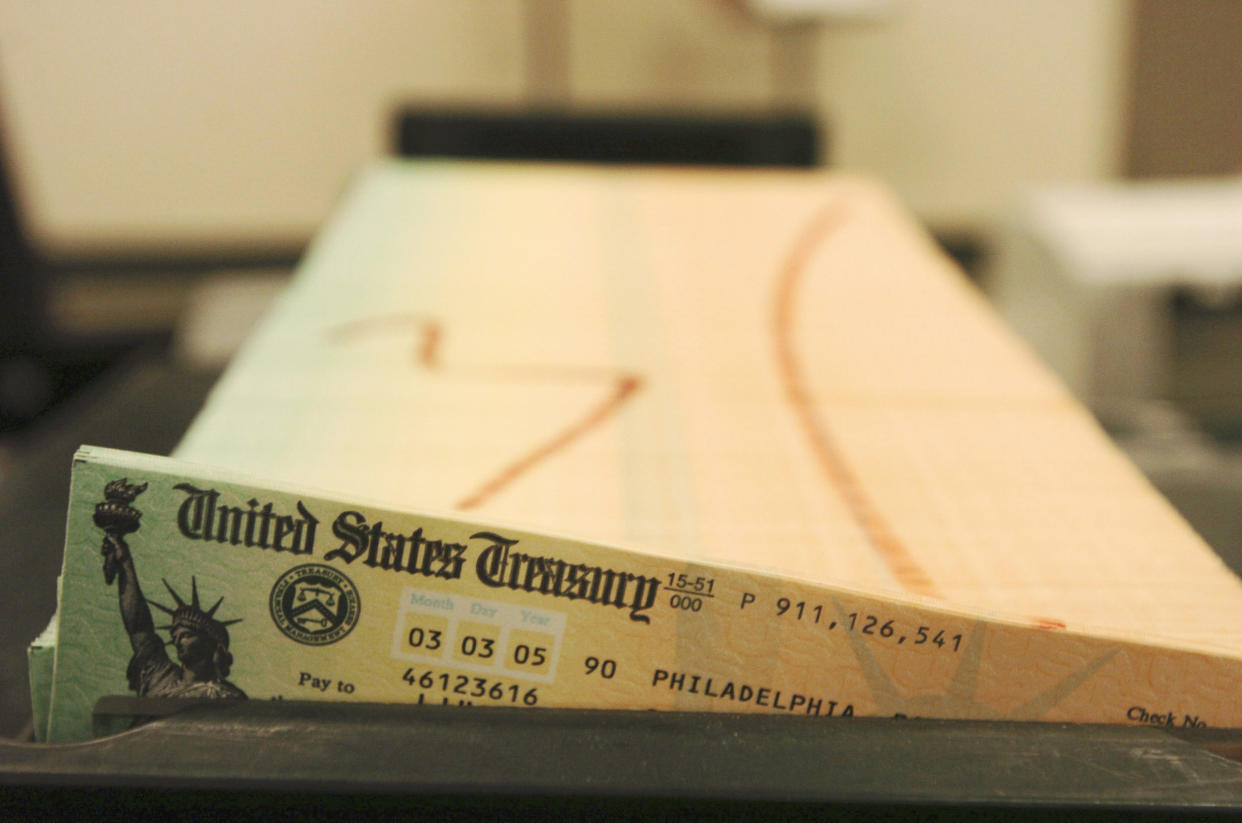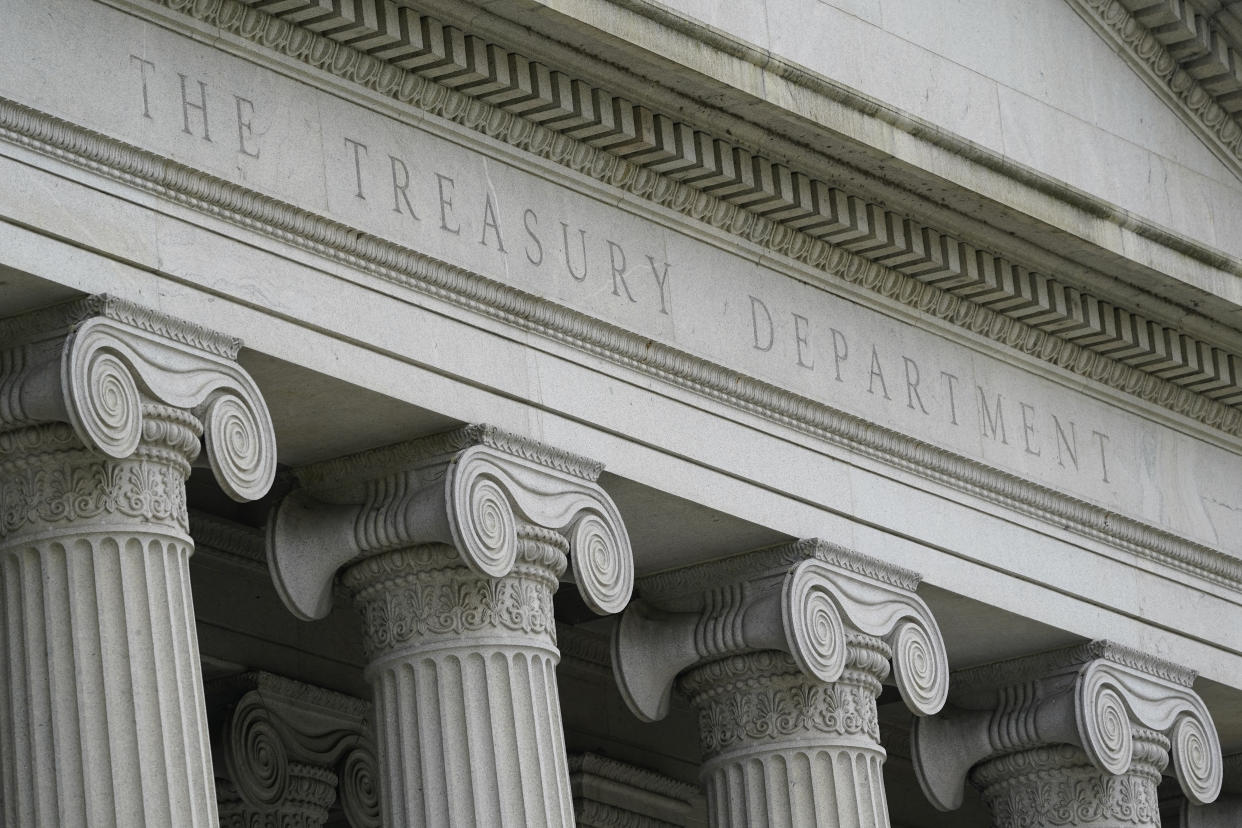Debt ceiling: What a US default could look like
It is impossible to predict exactly how things would unfold if the US takes the unprecedented step of defaulting on its debt in June.
What seems likely, experts tell Yahoo Finance, is that America and the world would experience a shocking initial crisis followed by more economic damage with each passing day. Markets could plunge just as Social Security and Medicare become unable to distribute money to those who need the government safety nets.
It's also clear US policymakers would have to make perilous choices about millions of other bills the federal government has to pay each month, especially if they want to buy more time and mitigate the fallout.
Who would be paid first: Treasury bondholders or retirees? Veterans or tax-refund recipients? Defense contractors or federal employees?
If bondholders get special treatment instead of Social Security recipients, the US would effectively be paying wealthy investors around the world “instead of paying off your grandma,” said Kroll's Global Chief Economist Megan Greene. “That's pretty politically toxic.”
The odds of a crisis rise each day even as Democrats and Republicans in Washington appear to be moving toward a deal.
There is still a fear that the delicate talks could collapse as both sides try to resolve final issues; one lead negotiator, Rep. Patrick McHenry (R-NC), warned reporters Thursday that "nothing is resolved." JPMorgan Chase recently pegged the chance of a default at 1 in 4.
If the previously unthinkable does happen, "I think just the notion that the US isn't making good on its promises is an initial shock," Greene said. "Then the cumulative effect will get much bigger" if the default continues.

First up: a 'mess'
Markets would almost surely be in for a wild ride if the day known as the "X-date" arrives when the US government is no longer able to pay all its bills.
Treasury Secretary Janet Yellen said Friday that could happen as early as June 5 without a deal, updating her previous estimate of June 1.
What could happen on that first day? White House Press Secretary Karine-Jean Pierre said "it would throw the economy into chaos."
Moody’s Analytics Chief Economist Mark Zandi largely agrees, saying "I think it will be very chaotic." On that day, he said "markets will be down, it'll be a mess."
But some say the underlying economic damage could be less than feared in those early hours if the Biden administration - as it is expected to do - enacts a plan to keep paying government bondholders and staves off a true default for at least a few days or weeks.
Wall Street is counting on such a move to temporarily avert a worst-case scenario. Strategas Securities Managing Director Jeannette Lowe even recently said that such prioritization could mean June 1 "actually wouldn't be a real default."
But even if the Treasury Department were to find a way to keep paying bondholders, far from a sure thing, there are also questions about whether investors would panic and push the economy into a recession no matter what.
"We know that the economy is often driven by consumer and business sentiment and if that falls off a cliff quickly, it's hard to get it back," notes Shai Akabas, the Bipartisan Policy Center's director of economic policy.
JPMorgan predicts adverse effects in the short term, including a possible downgrading of the US credit rating followed by “much worse outcomes” if the crisis drags out.
Up next: risks to Social Security, Veteran’s benefits, and more
If the government misses critical payments to high-profile programs, that could ratchet up the political pressure in the days following a default.
Some big ones are due at the beginning of June.
On the first day of the month the government is scheduled to make $47 billion in Medicare payments and provide $24 billion for government retirement plans and veterans benefits, according to the Bipartisan Policy Center, which recently compiled a detailed schedule of government payments that could be at risk.
The very next day, on June 2, $25 billion is due for Social Security recipients. Then billions more are scheduled to follow around things like Medicaid, government salaries, tax refunds and more.
Analysts at the Bipartisan Policy Center have zeroed in on a "elevated risk" of default happening between June 2 and June 13 — while Yellen has maintained that the X-date could happen anytime after June 1.
June 15 is another critical date. Moody’s Investors Service told Bloomberg that $2 billion in interest payments on Treasuries due that day are critical for the US to maintain its AAA credit rating. A rating downgrade is likely if those payments aren't made.
All bets would be off, of course, with a default that stretches for months. The economic costs would be severe. The White House has said that a protracted default - meaning one lasting a full quarter - would lead to a sharp recession, eliminate over 8 million jobs, and cause the stock market to plummet 45%.
‘Hard choices’
Treasury Secretary Yellen has provided mixed signals on how she much she might be able to prioritize which bills to pay if the US defaults, adding to the uncertainty.
On May 21, during an appearance on NBC’s "Meet the Press," she signaled that servicing the debt is the top priority with checks to Social Security recipients and military employees close behind.
"There will be hard choices to make about what bills go unpaid” she said.
But in a virtual conversation at the Wall Street Journal’s CEO Council on May 24, she cast doubt on the notion that the detailed prioritizing of payments was "operationally feasible."

"Our payment systems have been constructed to pay our bills, not to decide which bills to pay and which bills not to pay," she added.
Another often discussed form of prioritization would be to delay all payments except for principal and interest on the debt. Then - with the money left over - Treasury would pay its other bills in the order that they are due.
This option, which was weighed during the debt ceiling crisis of 2011, might be simpler operationally but is not so easy politically.
What happens, Akabas said, if the Treasury announces "Don't worry guys, we're making principal and interest payments, but everybody else is gonna have to wait in line."
"I wouldn't be filled with confidence as an investor if that's what I heard."
Ben Werschkul is Washington correspondent for Yahoo Finance. Jennifer Schonberger contributed reporting.
Click here for politics news related to business and money
Read the latest financial and business news from Yahoo Finance
